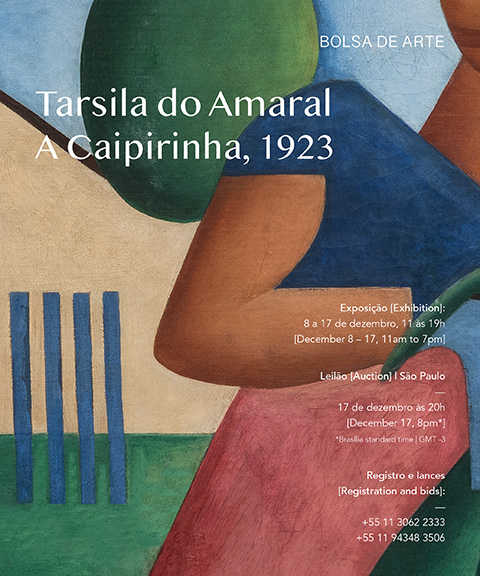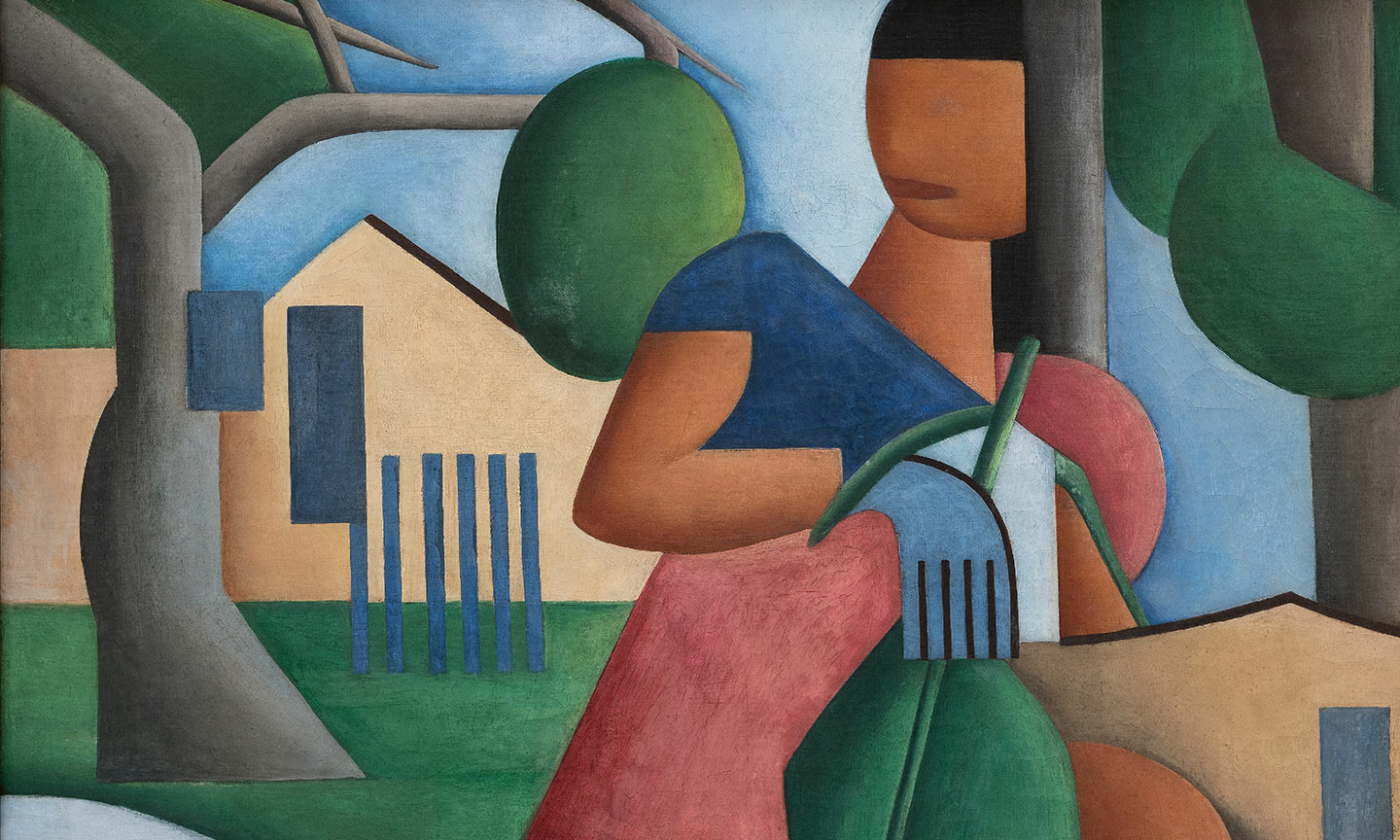
“I want, in art, to be the country-girl from São Bernardo, playing with leaf dolls, as in the last painting that I am painting”
— Excerpt from a letter from Tarsila do Amaral to the family, sent from Paris to Brazil in 1923
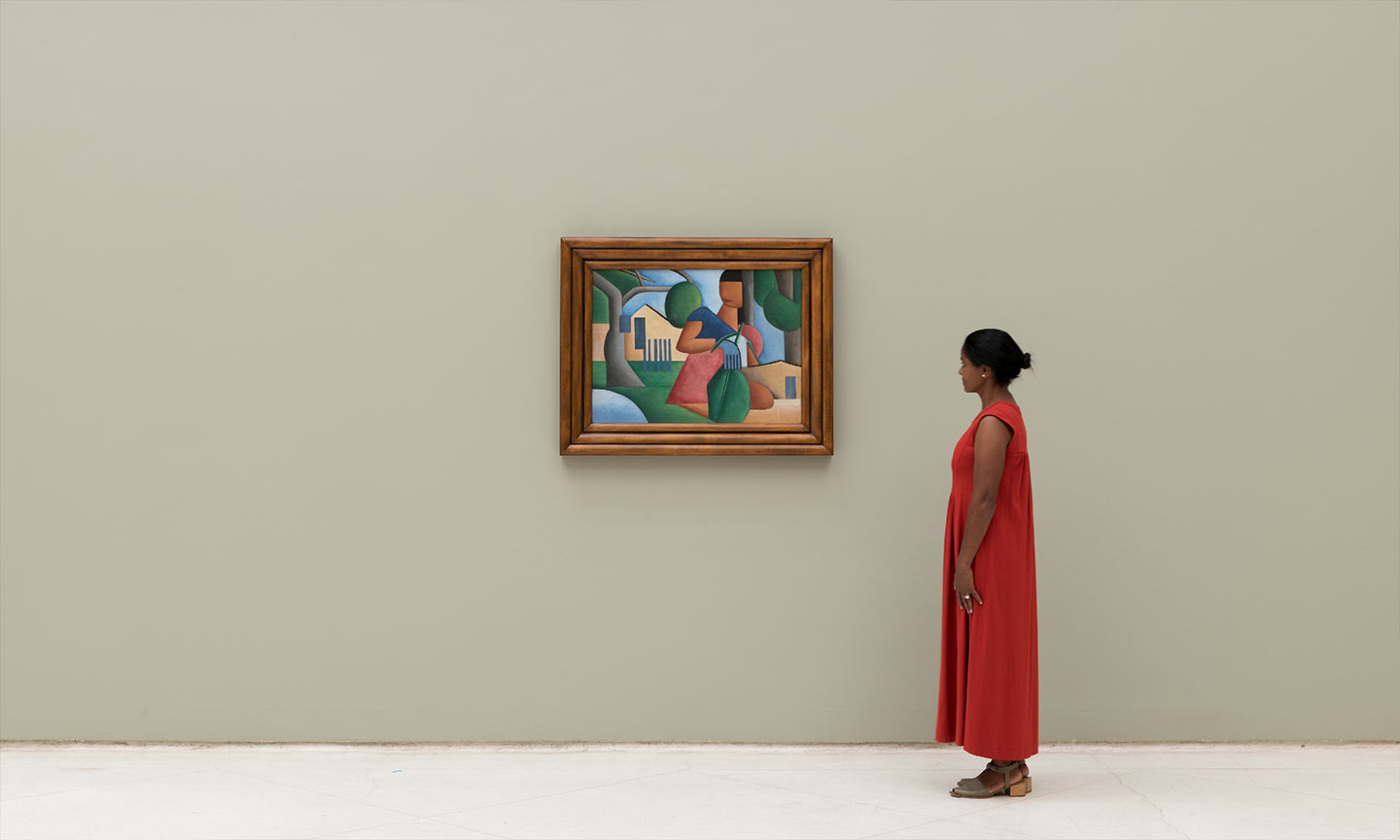
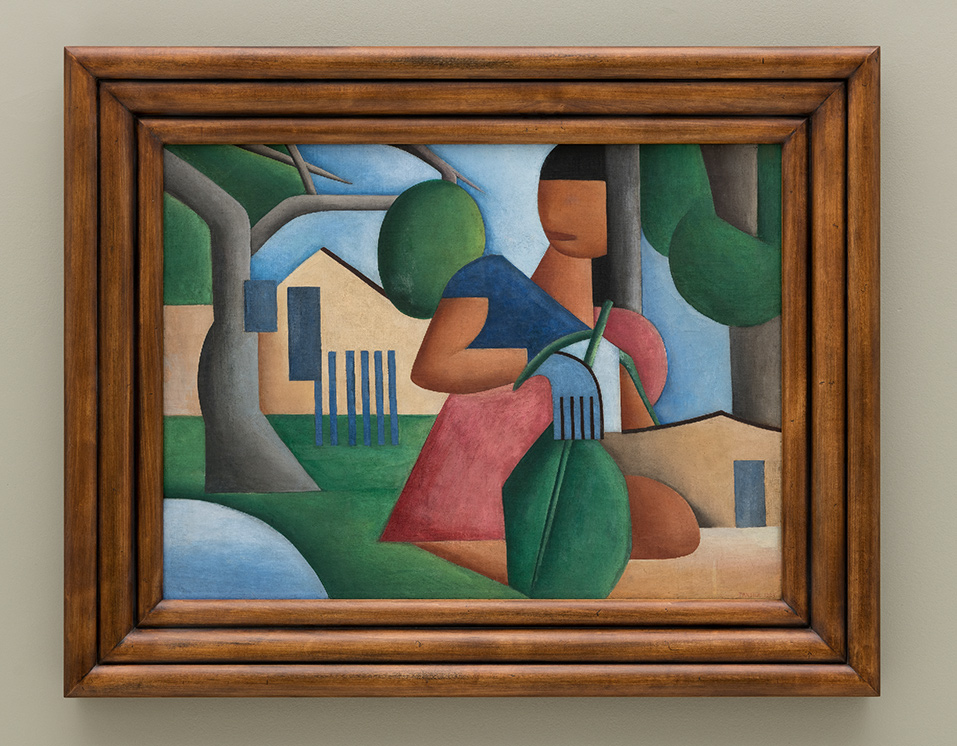
Tarsila do Amaral (1886 – 1973)
— A Caipirinha, 1923 Óleo sobre tela [Oil on canvas] Assinada e datada (inferior direito) [Signed and dated (lower right)] 60 x 81 cm [23 1/2 x 31 7/8 in.]
Starting bid:
R$ 47.613.848,66
Documentário
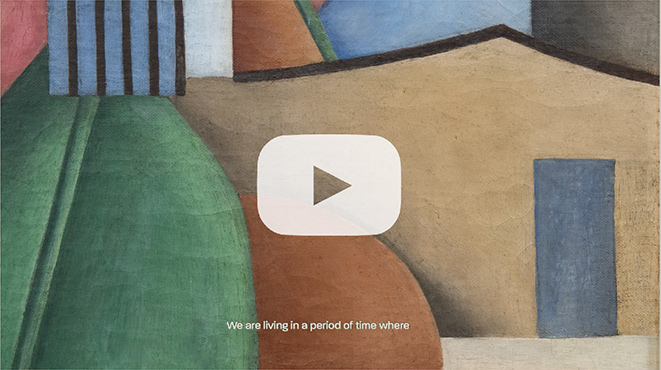
A Caipirinha, 1923
— Aracy A. Amaral
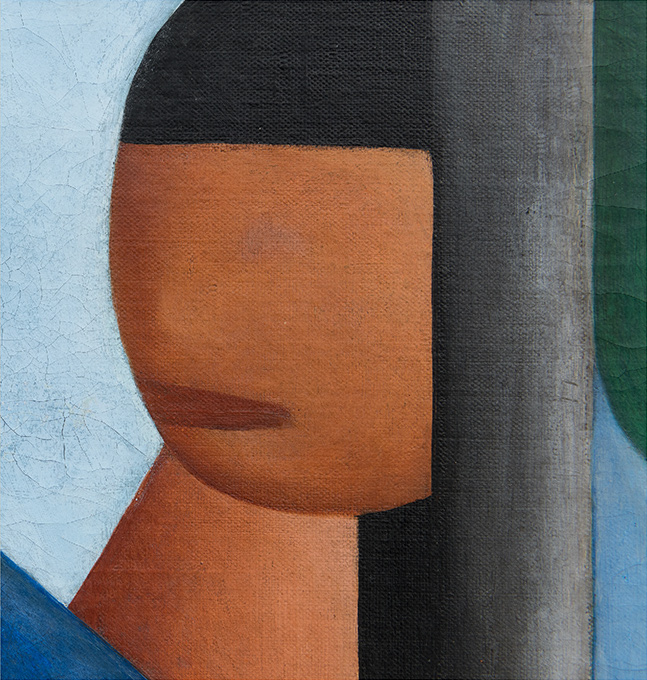
The closest sketch that we have of Caipirinha is certainly a simple drawing made by Tarsila do Amaral as an annotation and sent in the middle of a letter dated April 19 1923 to her family in São Paulo, to whom she wrote regularly reporting her activities in Europe: “... I want, in art, to be the country-girl from São Bernardo, playing with leaf dolls, as in the last painting that I am painting.”
Such documents are clues not only to the dating of this work, but also to understanding Tarsila’s development, by leaps and bounds, as a painter in that year of 1923. Period in which her learning successively unfolds through stages with André Lhote, Fernand Léger and Albert Gleizes. Tarsila went from portraits full of diagonals and soft bluish colors like those of Oswald de Andrade and Sergio Milliet in view of Pont Neuf, to the vibrant Figure in Blue and Manteau Rouge; from the cubist Still Life with watches to the “legerian” academy, until reaching Rio de Janeiro, Caipirinha and, finally, the striking strength of A Negra.
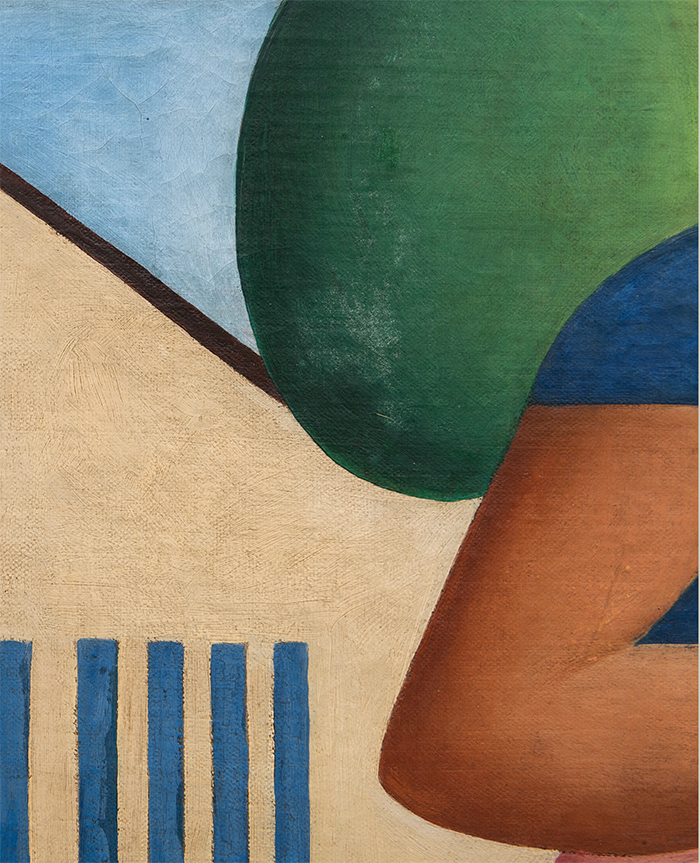
The year of 1923, was, at last, full of experiences; social and pictorial experiences for her personal life. It was a fundamental year in her stay in Paris with Oswald de Andrade, where she established a network of contacts with the French cultural environment that she would cultivate throughout the decade. Through the Swiss- French poet, Blaise Cendrars, the couple would be introduced to the “crème de la crème” of the French artistic milieu.
In that same year, Tarsila also met Dona Olivia Guedes Penteado, a future patron of the arts through Paulo Prado. In the following year, according to Tarsila’s testimony given on May 13 1971 to a group of artists and historians from MIS (Museum of Image and Sound of São Paulo), the illustrious paulista renovates her stable in her mansion at Conselheiro Nébias Street, in the São Paulo capital. She transformed it into a “modern pavilion” on the occasion of having started to acquire works from modern artists, in this case, a Léger. For this space, Lasar Segall would be invited to make an abstract panel, impressive for the times.
Tarsila then offered Caipirinha as a gift for this prestigious pavilion. When Dona Olivia passed way, the painting went to her daughter Carolina Silva Telles, later passing on to her grandson Goffredo Silva Telles Junior and being sold to Salim Taufic Schahin in the 1990s.
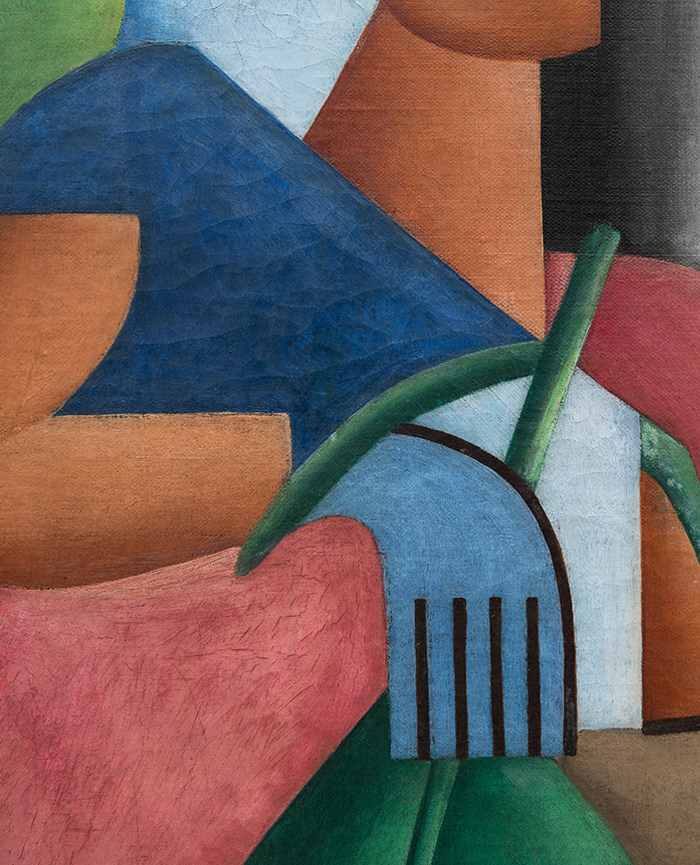
“In Caipirinha I harnessed a memory from when I was a child. When I was little I used to play with some tall grass that grew near the wall (in the farm). I would cut it, it was very flexible, and made a doll. I would make the arms, then a little skirt ... I remembered to place a similar type of leaf in the painting” (MIS 1971 / Folha de S. Paulo, “Saudades Caipirinha”, 16 Feb. 1975).
On the canvas it is possible to perceive a very deliberate attempt at geometrizing the compositional elements, visibly wanting to reconcile the rural landscape, that Tarsila affectionately projects, with a set of geometrical figures already underway in her work.
Nesta pintura vemos, assim, a sequência de verticais – cerca simbica, troncos de árvores estilizadas, mão, portas – articulando-se com figuras esféricas, além de diagonais perceptíveis nos telhados das casas, vestido e corpo, em triangulação bem visível em elementos da figura dominante.
In this painting we see, thus, a sequence of verticals – symbolic fence, stylized tree trunks, hand, doors – articulating with spherical figures, as well as perceptible diagonals in the roofs of the houses, dress and body, in a triangulation visible in elements of the dominant figure.
The warm color palette partially appears, in this same year, in “academies” with models due to Léger’s influence. But, in Caipirinha the artist, aware of the pictorial synthesis acquired in Paris in 1923 through the cited masters, forecasts the strength of choice for a modern posture with remarkable loyalty to her values of the Brazilian land.
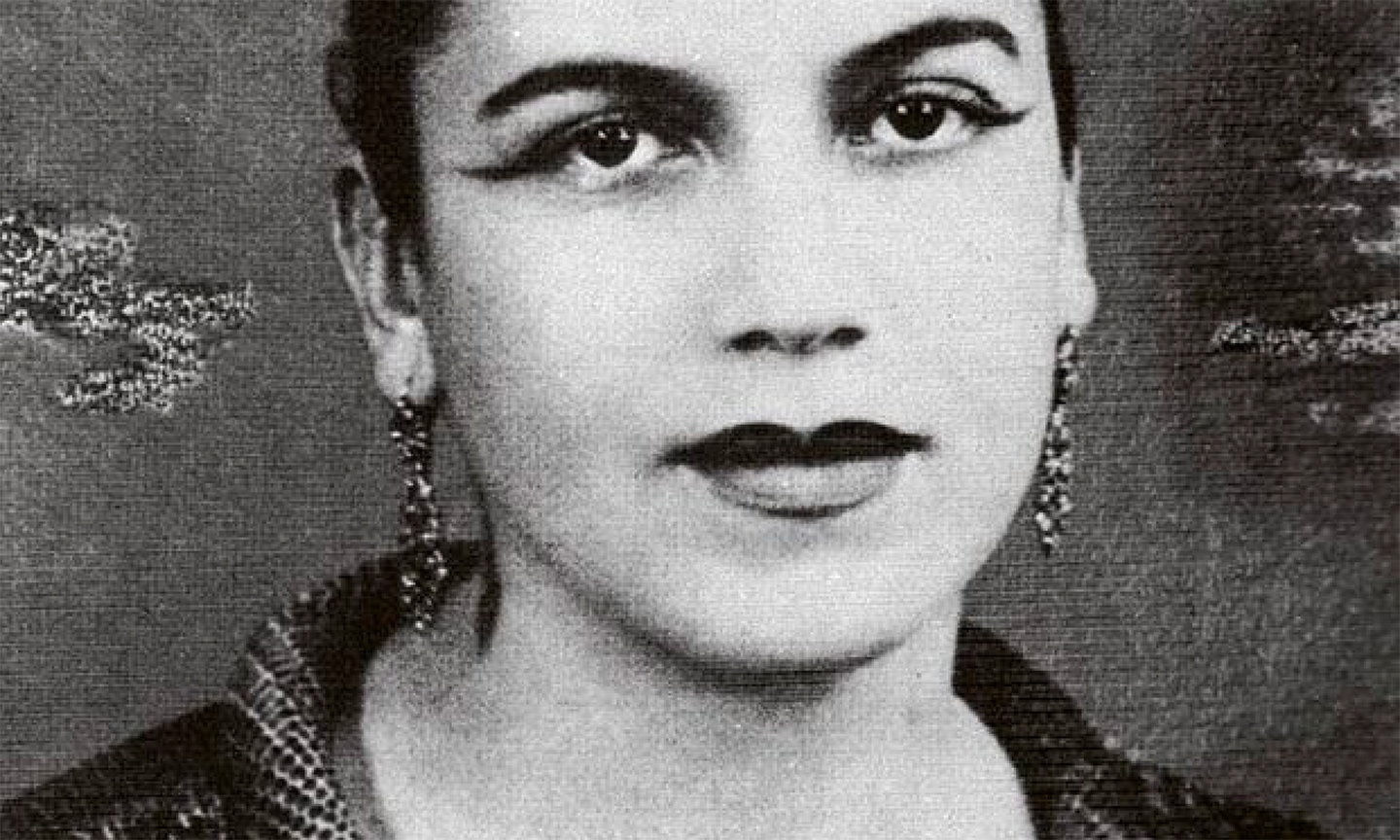
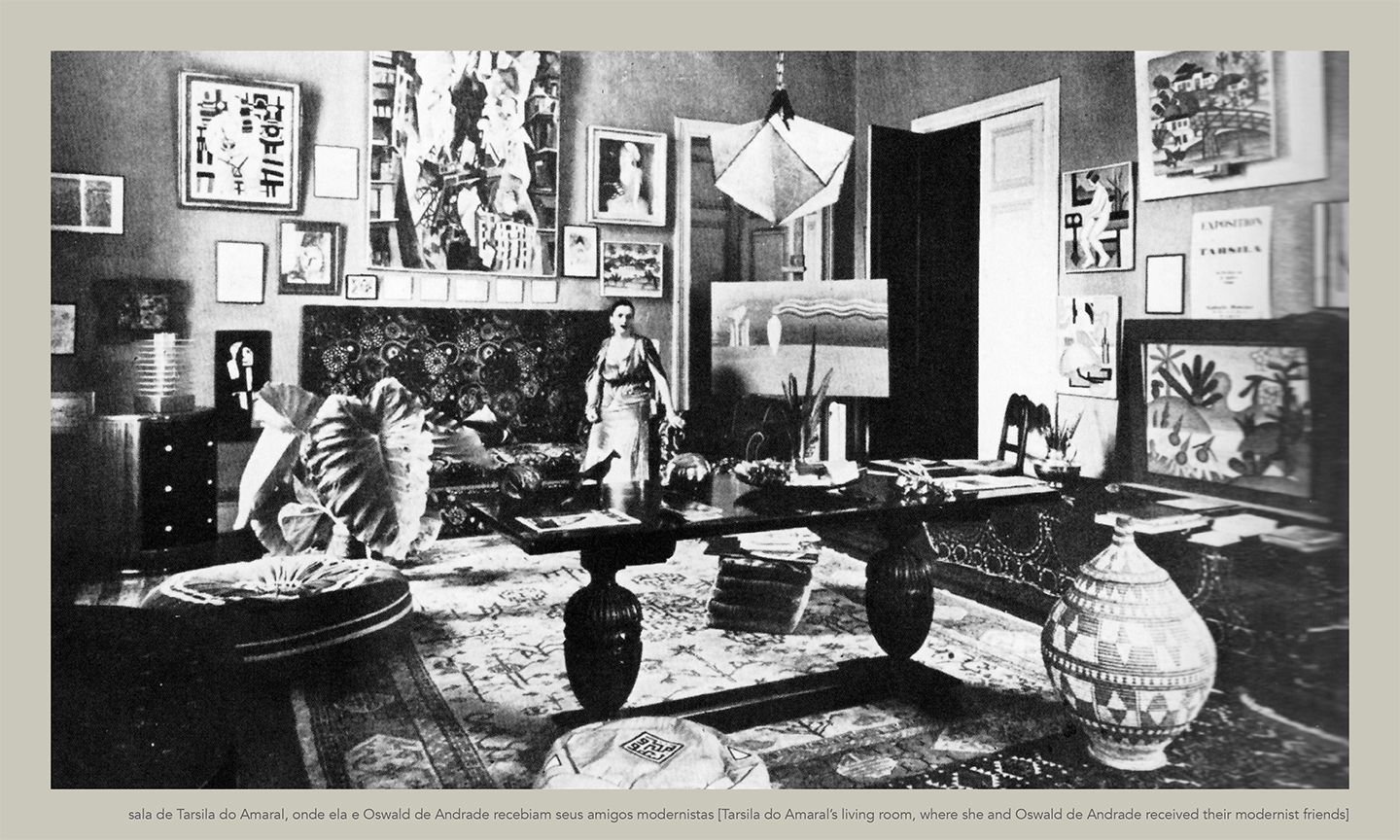
Tarsila do Amaral, from 1923 to posterity
Nineteen twenty-three: Tarsila do Amaral returns to Paris, where she will live through determining experiences for her artistic work and will start to make paintings with her own language that had not been developed until then, with themes, colors and forms that will mark her main pieces thereafter. Tarsila states: “the year of 1923 was the most important year in my artistic career” and “a new world revealed itself” to her spirit when she started to take classes with André Lhote, with whom she studied for three months in the first semester. In this period, she painted the famous self-portrait Manteau Rouge, in which she applied Lhote’s lessons in portraying how she had dressed in a dinner party offered to Santos Dummont by the Brazilian embassy: the artist would have caught the guests’ attention with her famous designer red dress, her elegant hairstyle and her lipstick, also red. A bit later, Tarsila would paint Caipirinha, making use of reminiscences from her childhood in her family farm in the countryside of São Paulo, combined with the principles of cubism to which she had just been introduced. Between September and October, she started to take lessons with Fernand Léger, who was impressed by the painting A Negra, a genesis of constructions which later on would unfold into Tarsila’s anthropophagic phase. Léger certainly
was the most relevant among the teachers she had
had that year: there was no reluctance against the
master’s inevitable influence over her own work,
she knew how to take advantage of the method’s
intelligence and pictorial synthesis, combining
these elements with aspects from her Brazilian
identity, which little by little, was perceived as
valuable within the foreign scenario. In a letter
to her family, she shares this observation: “Don’t
think that this Brazilian tendency in art is poorly
looked upon here. On the contrary. What they
want here is for each one to bring a contribution
from their own country. (...) Paris is tired of Parisian
art.”
Delightful and a symbol of an instigating
and unknown universe, Tarsila was very well
received by the Parisian artistic class. Along with
her companion, Oswald de Andrade, they met
great figures such as Brancusi and Jean Cocteau,
introduced to them by Blaise Cendrars, a French
poet that they met in May 1923 and with whom
they became great friends. It was also at that time
that the artist met Pablo Picasso in a significant
visit to his studio, an episode commented in a
chronicle that she wrote in 1936: “It was full of
emotion that I went up to the master’s studio. I
wanted to hear from his mouth the magic word
that would unveil to me the hieroglyphic world of
Cubism”, and from there, after a brief discussion
about Le Douanier Rousseau’s painting, she left
with the following message: “Seek contact with
good works of art in order to feel them”. A short
time after, she took lessons with Albert Gleizes,
her last painting teacher from that year, and,
probably the most cerebral of all. Tarsila does not
shy way from learning with Gleizes, but continues
to resonate Picasso’s message: to the refined
technique acquired, add affection and the subject
of your origins, of your memories and, with her
return to Brazil, her passionate observation of the
landscape.
At the beginning of 1924 Tarsila is already
back in São Paulo and applies herself to the
production of her “very Brazilian” pieces, as she
herself stated about Cuca, which she started to
paint in February of that year. We can thus see
the unfolding of her experiences in Paris and
the effects of a shift that acted as a revealing
mechanism of an identity that until 1923 Tarsila
had not claimed as her on, but, which she was
encouraged to recognize and through which
she gained distinction the artistic milieu. The
trip she undertook with Oswald, his son, Nonê,
D. Olívia and her grandson Goffredo, Mário de
Andrade, Blaise Cendrars and Rená Thiollier
to Rio de Janeiro and through the countryside
of Minas Gerais, promoted a perceptive and
thematic unload, which is mainly evidenced in the
following account, which marks the artists entry
into her “pau-brasil” phase: “In Minas Gerais I
found the colors that used to love as a child. Later,
they taught me that they were ugly and crude.
I followed the monotony of refined taste... But
later I took revenge on the oppression by taking
them to my paintings: the purest blue, violet
pink, lively yellow, singing green, all in more or
less strong gradations according to the mixture of
white. A clean painting, above all, without fear of
conventional canons.”
From that moment on, Tarsila establishes
herself as an artist with a unique language and it
does not take long for her recognition to arrive.
In 1926, she held her first solo exhibition in Paris
with works dating from 1923 to 1926. In 1928, she
paints Abaporu, and the figure that composes the
painting, a type of monster or unknown mythical
entity, greatly impresses Oswald de Andrade
and inspires him to write the Anthropophagic
Manifesto, and to defend, as a primordial
procedure for the emancipated Brazilian artistic
production, the gesture of appropriating the
strength of foreign elements by swallowing and digesting them, in this way, being nourished by them to produce something new, authentic. This anthropophagic phase of modernism, unleashed by Tarsila do Amaral’s figurations, became one of the most remarkable moments in the history of Brazilian art, echoing in several other movements, especially in Tropicalismo at the end of the 1960s. Caetano Veloso himself, one of the exponents of this generation, later stated in an interview with Augusto de Campos that “Tropicalism is a neoanthropophagism.” Before that, in 1967, Hélio Oiticica had already made the importance and influence of that moment very clear in order to illustrate what he understood as a “general constructive will in Brazil”: “Even in the Movement of 22 one could verify this, being, in our opinion, the reason that led Oswald de Andrade to the renowned conclusion of what would be our anthropophagic culture. (...) This wouldn’t happen if there weren’t, latent in our way of learning such influences, something special, characteristically ours, that would be this general constructive will.”
Therefore, the protagonist of an important
legacy of art for Brazilian culture, Tarsila do Amaral,
is one of our most renowned artists. Currently,
several of her works can be found in international
museums, such as, Cuca, 1924, which is part of the
collection of the Musée de Grénoble, in France;
Abaporu, 1928, which resides in the Museu de
Arte Latino-americana in Buenos Aires – Malba,
in Argentina; Pescador, 1925, located at the
Hermitage Museum in Russia, and A Lua, 1928,
recently acquired by MoMa – NY in 2019.
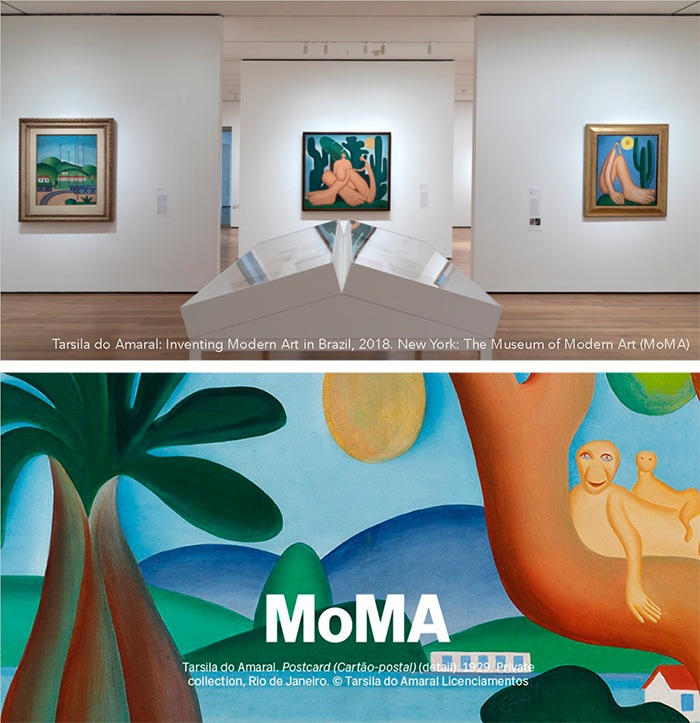
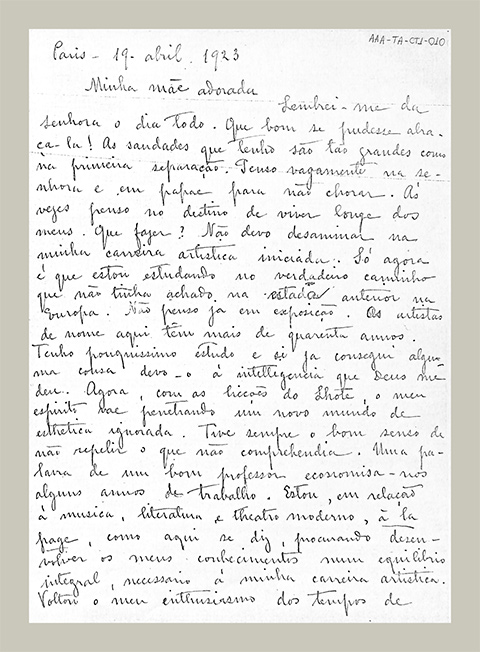
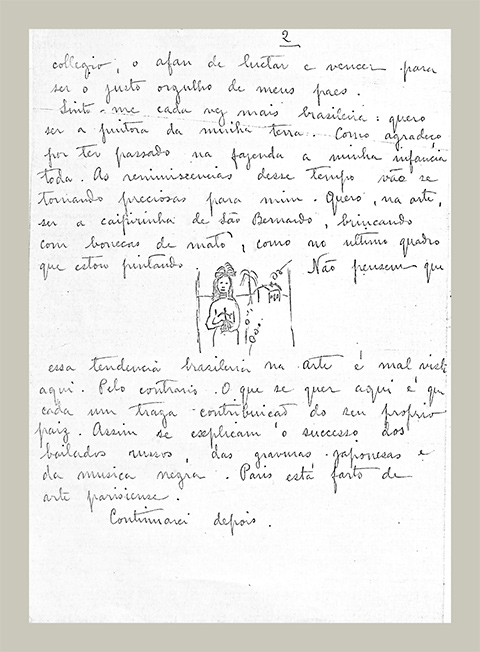
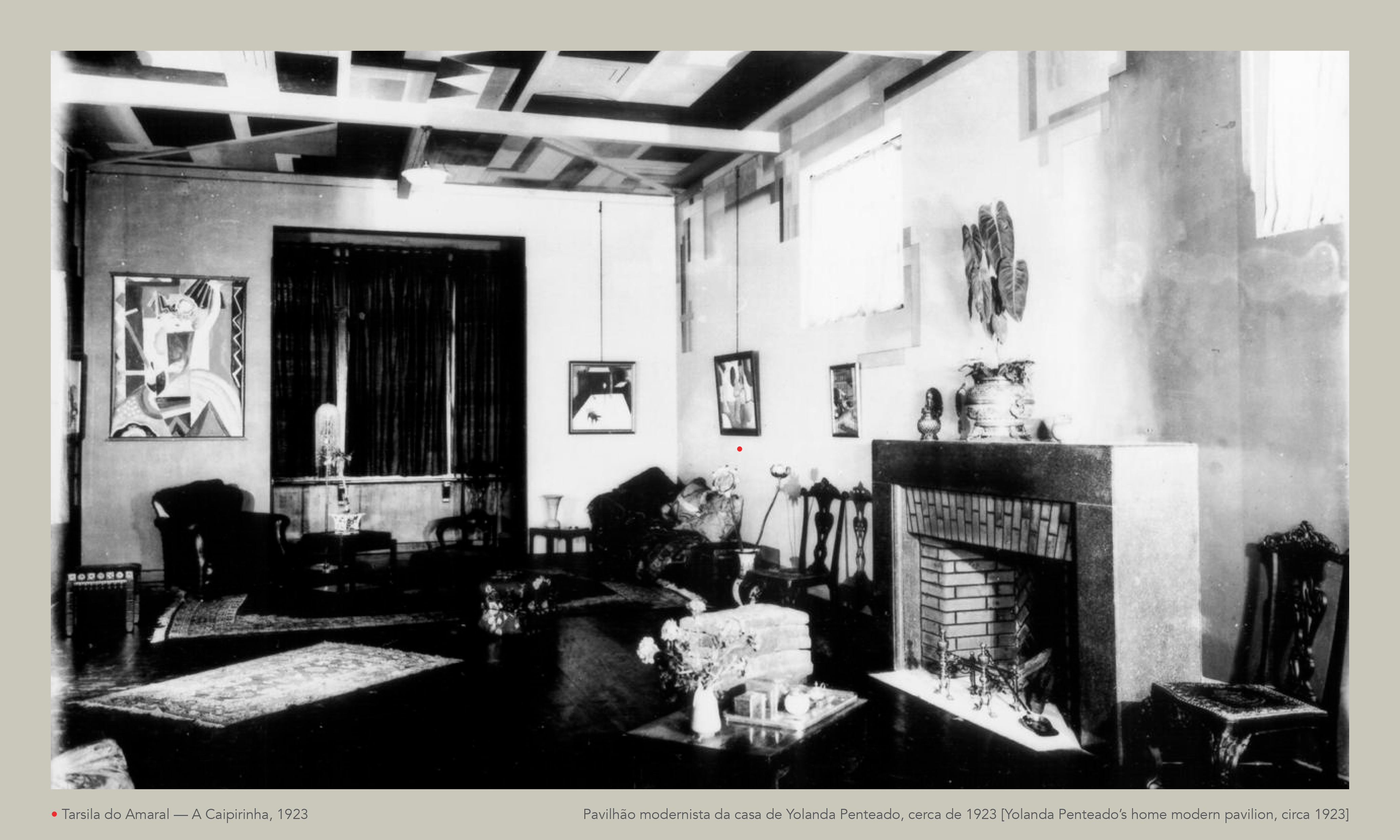
The affective path of an artwork
It was in the decisive year of 1923, in Paris,
that Tarsila do Amaral and Dona Olívia Penteado
met, marking the start of a lasting friendship.
Tarsila, who had just established herself in the city
circulated between the studios of great artists,
learning their cubist lessons. She was presented
to D. Olívia by Paulo Prado, and, along with her
partner, Oswald de Andrade, they were guided
through avant-garde art galleries of Paris, being
introduced to a universe which she still had
little contact with. Such strolls resulted in Dona
Olívia’s acquisition of important works that would
inaugurate her collection of modern art, such as
the canvas, Compotier aux Poires, by Fernand
Léger, one of the masters with which Tarsila
studied. Becoming aware of her friend’s intentions
to create what came to be called the “modernist
salon” in the until then unused stable in her house
in São Paulo, Tarsila offered Olívia that which she
judged to be one of her best paintings at the time,
Caipirinha.
In this way, the work in question sealed
a bond that would grow stronger throughout
the years. Among the most significant episodes
from this friendship was the trip in which Tarsila,
Oswald and his son, Nonê, D. Olívia and her
grandson Goffredo, Mário de Andrade and René
Thiollier undertook in 1924 to meet and show
the French poet Blaise Cendras, who was visiting
Rio de Janeiro’s carnaval, the historical cities of
Minas Gerais. It was a dazzling experience for
the painter recently-arrived from Europe, and
it opened up a universe of colors and themes
until then seldom seen in her work, developed
into paintings like Carnaval em Madureira and
Morro de Favela. Since then, Olívia and Tarsila
never stopped admiring and visiting each other
until the patroness of the arts’ death in 1934 –
Tarsila writes about her friend in a chronicle from
1936: “Everything, in this illustrious woman from
São Paulo, was distinction, was elegance, was
understanding, was love for artistic and beautiful
environments.” After her departure, Caipirinha is
passed to Carolina Silva Telles, her daughter, and
afterwards to her grandson, the professor, lawyer
and jurist, Goffredo Silva Telles Junior.
Goffredo, being very attached to his
grandmother, was always around and lived among
her distinct friends, having his own stories to tell
about each one. Tarsila was one of his favorite
artists among all that he had met, and he studied
drawing with her for a few months when he
was young. Always portrayed as an
enchanting personality, the painter was truly admired by this family who played a decisive role in the artistic and cultural development of the city of São Paulo. If D. Olívia, according to Tarsila, “organized one of the most opulent and interesting galleries in Brazil, with works by Picasso, Léger, Brancusi, Lhote and other renowned names,” her cousin, Yolanda Penteado (1903- 1983), nicknamed “country girl from Leme” by Assis Chateaubriand, was responsible for creating the initial collection of the Museum of Modern Art of São Paulo – MAM-SP - and for organizing, along with her husband, Ciccillo Matarazzo (1898- 1977), the 1st International Biennial of São Paulo, inaugurated in 1951, besides other editions of the great event. Therefore, we are talking about a family whose own history is mixed up in the history of institutionalization of art in São Paulo and Brazil’s insertion in the international art market.
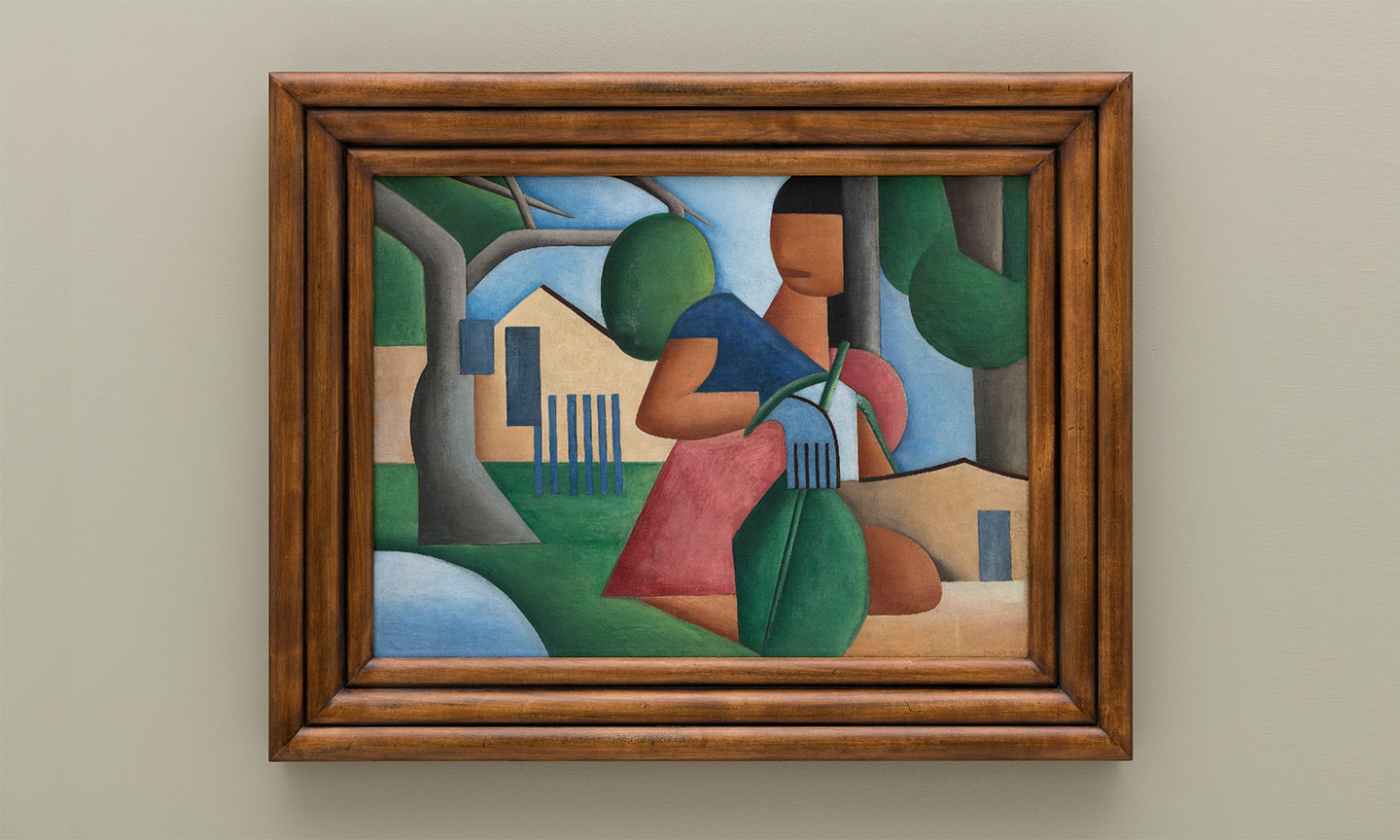
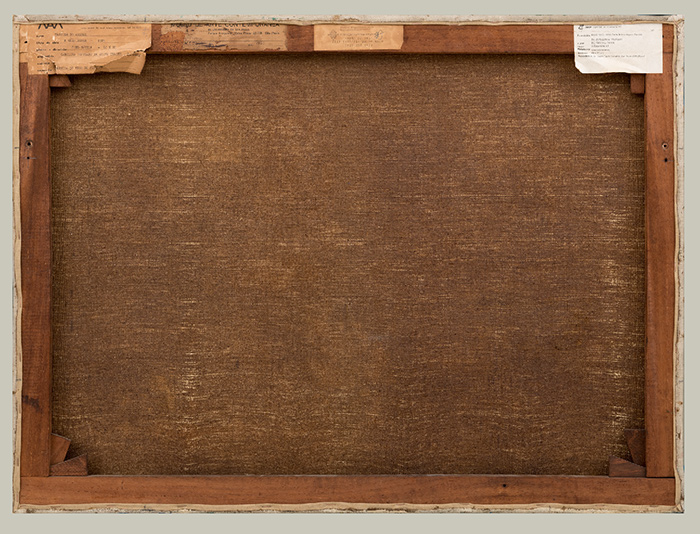
Exhibitions
Tarsila. Palace Hotel: Rio de janeiro, July, 1929 ;
Edifício Glia: São Paulo, September, 1929 ;
Tarsila do Amaral: Retrospectiva. Palace Hotel: Rio de Janeiro, October, 1933 ;
Tarsila 1918-1950. Museu de Arte Moderna de São Paulo - MAM/SP: São Paulo, December, 1950 ;
Tarsila: 50 Anos de Pintura. Museu de Arte Moderna do Rio de Janeiro - MAM/RJ: Rio de Janeiro, April to May, 1969 ;
Museu de Arte Contemporânea da Universidade de São Paulo - MAC/USP: São Paulo, May to June, 1969 ;
38a Exposição Geral de Belas Artes (Salão Revolucionário). Escola Nacional de Belas Artes - Enba: Rio de Janeiro, September, 1931 ;
7a Bienal Internacional de São Paulo. Fundação Bienal de São Paulo: São Paulo, 28 de September 28th to December 22nd, 1963 ;
32a Biennale de Venezia. Pavilhão do Brasil: Venezia, June 20th to October 18th, 1964 ;
7o Salão Nacional de Artes Plásticas (Salão de 31). Sala Especial do Salão Nacional de Artes Plásticas: Fortaleza, December, 1984 to January, 1985 ;
24a Bienal Internacional de São Paulo. Fundação Bienal de São Paulo: October 3rd to December 3rd, 1998 ;
De la Antropofagia a Brasília: Brasil 1920-1950 / Da Antropofagia a Brasília: Brasil 1920-1950; Instituto Valenciano de Arte Moderna: Valencia, October 26th, 2000 to January 14th, 2001;
Museu de Arte Brasileira - MAB-FAAP: São Paulo,November 30th, 2002 to March 2nd, 2003 ;
Art in Brazil (1950-2011) : europalia.brasil. Bozar Centre for Fine Arts: Brussels, October 11th, 2011 to January 15th, 2012.
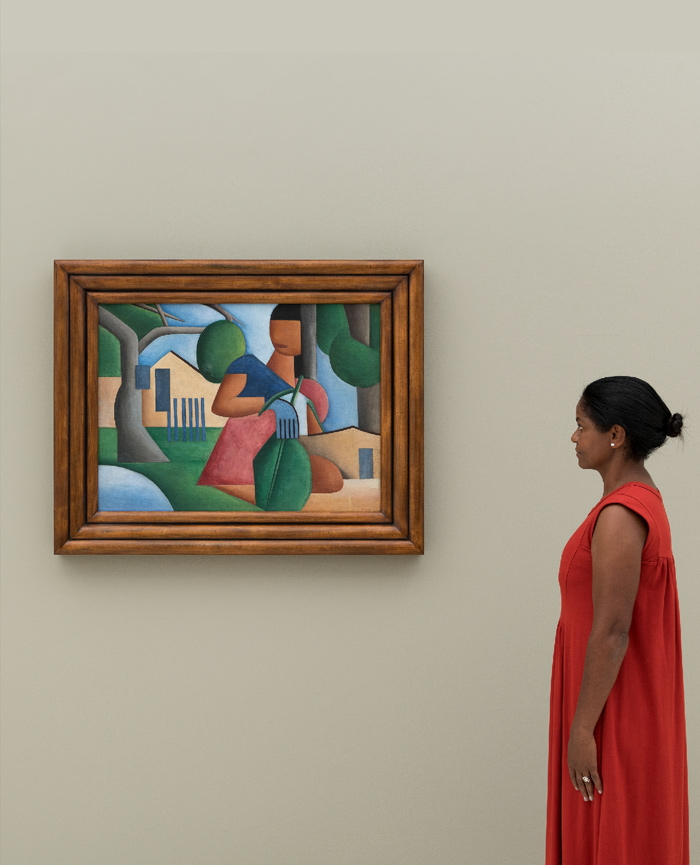
Bilbiography
Catálogo Raisonné Tarsila do Amaral / Catalogue Raisonné Tarsila do Amaral - 3 volumes. São Paulo:
Base 7, 2008, vol. 1 - p. 98;
Tarsila: Sua Obra e Seu Tempo. São Paulo: Edusp/Perspectiva: 1975, vol. 1, p. 72; vol. 2, p. 20
Arte Brasileira: Interfaces para a Contemporaneidade. São Paulo: Museu de Arte Contemporânea da
Universidade de São Paulo, 2005, p. 179 (citação [quotation]);
Tarsila: Sua Obra e Seu Tempo. São Paulo: Tenege, 1986, p. 97;
Arte Construtiva no Brasil: Coleção Adolpho Leirner. São Paulo: Companhia Melhoramentos, 1998, p. 73;
Correspondência Mário de Andrade & Tarsila do Amaral. São Paulo: Edusp/IEB USP, 2001, p. 77; p. 79
(citação [quotation]);
Tarsila Cronista. São Paulo: Edusp, 2001, p. 27 (citação [quotation]);
Tarsila: Sua Obra e Seu Tempo. São Paulo: Editora 34/Edusp, 2003, prancha [plate] IV;
Textos do Trópico de Capricórnio: Artigos e Ensaios (1980-2005). São Paulo: Editora 34, 2006, p. 27; p. 50
(citação [quotation]);
Tarsila. São Paulo: Grupo Takano/Sesc São Paulo, 2003, p. 40;
Tarsila por Tarsila. São Paulo: Celebris, 2004, p. 40;
Aspectos da Pintura Brasileira. Rio de Janeiro: Spala Editora, 1979, p. XXXVII (citação [quotation]);
Encontro com Tarsila do Amaral. São Paulo: Minden Editora, 199-, p. 13;
Modernidade: Vanguardas Artísticas na América Latina. São Paulo: Fundação Memorial da América Latina/
Editora Unesp, 1990, p. 180 (citação [quotation]);
5 Mestres Brasileiros: Pintores Construtivistas: Tarsila, Volpi, Dacosta, Ferrari, Valentim. Rio de Janeiro:
Livraria Kosmos Editora, 1977, p. 11 (citação [quotation]);
A Aventura Brasileira de Blaise Cendrars: Ensaio, Cronologia, Filme, Depoimentos, Antologia. São Paulo:
Editora Quirón, 1978, p. 265 (citação [quotation]);
Tarsila do Amaral: a Modernista. São Paulo: Ed. Senac, 2000, p. 85 (citação [quotation]);
O Banquete Canibal: a Modernidade em Tarsila do Amaral. Curitiba: Ed. UFPR, 2002, p. 54, 55;
Tarsila: Obras 1920/1930: 60 anos da Semana de Arte Moderna. Rio de Janeiro: IBM do Brasil, 1982, p. 73;
Tarsila. São Paulo: Art Ed., 1991, p. 43;
Paisagens Brasileiras. São Paulo: Difusão Cultural do Livro, 2003, p. 24, 25, 57;
Aspectos da Arte Brasileira. Rio de Janeiro: Funarte, 1981, p. 114 (citação [quotation]);
Tarsila do Amaral. São Paulo: Callis, 1998, p. 23;
História Geral da Arte no Brasil. São Paulo: Instituto Walther Moreira Salles/Fundação Djalma
Guimarães, 1983, p. 557 (citação [quotation]);
Salão de 1931: Marco da Revelação da Arte Moderna em Nível Nacional. Rio de Janeiro: Funarte/
INAP, 1984, p. 150;
Acervo Artístico-Cultural dos Palácios do Governo do Estado de São Paulo. São Paulo: Imprensa
Oficial do Estado, 199?, p. 61 (citação [quotation]);
Coleção Mário de Andrade: Artes Plásticas. São Paulo: IEB USP, 1984, p. XXXIX (citação [quotation]);
Coleção Mário de Andrade: Artes Plásticas. 2a Ed. São Paulo: IEB USP, 1998, p. XXXIX (citação
[quotation]);
Tarsila: 1918-1968. Rio de Janeiro: Museu de Arte Moderna de São Paulo - MAM/SP, 1969, p. 57
(ficha técnica [fact sheet]);
Tarsila do Amaral na BM&F: Percurso Afetivo – 120 Anos de Nascimento. São Paulo: BM&F, 2006,
p. 9 (citação [quotation]);
Tarsila Viajante = Tarsila Viajera. São Paulo: Pinacoteca do Estado, 2008, p. 26;
Tarsila do Amaral: Peintre Brésilienne à Paris. Rio de Janeiro: Imago Escritório de Arte, 2005, p. 24,
26, 69, 85, 86, 103 (citação [quotation]);
Tarsila: 1918-1950. São Paulo: Museu de Arte Moderna de São Paulo - MAM/SP, 1950, p. 10
Tarsila: Rio 1929. São Paulo: Typ. Bancária, 1929, p. 3 (ficha técnica [fact sheet]);
Tarsila: S. Paulo 1929. São Paulo: Typ. Bancária, 1929, p. 3 (ficha técnica [fact sheet]);
7a Bienal de São Paulo. São Paulo: Fundação Bienal, 1963, p. 95 (ficha técnica [fact sheet])
32a Biennale de Venezia. Venezia: s.n., 1964;
Brasil-Brasis: Cousas Notaveis e Espantosas: a Construção do Brasil: 1500-1825. Lisboa: Comissão
Nacional para as Comemorações dos Descobrimentos Portugueses, 2000, p. 37 (citação [quotation]);
38a Exposição Geral de Belas Artes. Rio de Janeiro: Escola Nacional de Belas Artes - Enba: Rio de
Janeiro, 1931, s.p. (citação) [n.p. (quotation]);
La dona, metamorfosi de la modernitat. Barcelona: Fondació Joan Miró, 2004, p. 120 (citação
[quotation]);
No Tempo dos Modernistas: D. Olívia Penteado, a Senhora das Artes. São Paulo: MAB Faap, 2002,
p. 161;
De la Antropofagia a Brasília: Brasil 1920-1950. Valencia: Instituto Valenciano de Arte Moderna,
2000, p. 63;
Da Antropofagia a Brasília: Brasil 1920-1950. São Paulo: Cosac & Naify/MAB-FAAP, 2002, p. 63;
Recordações de Paris. São Paulo: Habitat, no 6, 1951, p. 19;
Da Antropofagia a Brasília: Brasil, 1920-1950. São Paulo: Qualimetria, no 136, dezembro de 2002
[December, 2002];
Tarsila em Revista. São Paulo: Capivari, v. 1, junho de 2002 [June, 2002], p. 13, 35;
Lembranças da Grande Festa. Rio de Janeiro: Arte Hoje, ano 1 [year 1], no 5, novembro de 1977
[November, 1977], p. 34 (citação [quotation]);
VII Bienal de São Paulo. São Paulo: Habitat, no 74, dezembro de 1963 [December, 1963], p. 6
(citação [quotation]);
Atualidade e Expressão de Tarsila. Rio de Janeiro: Comentário, julho a setembro de 1968 [July to
September, 1968], p. 113 (citação [quotation]);
Uma Caipira que Fez História. São Paulo: Visão, 28 de janeiro de 1966 [January 28th, 1966], p. 45
(citação [quotation]);
Correspondência de Mário para Tarsila. São Paulo: O Estado de S. Paulo, 3 de agosto de 1968
[August 3rd, 1968], p. 3 (citação [quotation]);
Significação de Tarsila. São Paulo: O Estado de S. Paulo, 3 de maio de 1968 [May 3rd, 1969], p. 3
(citação [quotation]);
Roteiro de Tarsila. São Paulo: O Estado de S. Paulo, 12 de abril de 1969 [April 12th, 1969], p. 4
(citação [quotation]);
Encontro de Tarsila com Tarsila. São Paulo: Diário de São Paulo, 5 de junho de 1969 [June 5th,
1969], p. 5 (citação [quotation]);
Tarsila do Amaral, A Primeira Dama da Pintura Brasileira. Belo Horizonte: Municípios Mineiros, 24
de setembro de 1986 [September 24th, 1986], p. 7 (citação [quotation]);
Seu Papel e Sua Glória. São Paulo: O Estado de S. Paulo, 12 de abril de 1969 (April 12th, 1969),
p. 5 (citação [quotation]);
Tarsila, A Pintora dos Sonhos Brasileiros. São Paulo: O Estado de S. Paulo, 17 de outubro de 1982
[October 17th, 1982], p. 12 (citação [quotation]);
Tarsila: Postais do Modernismo. São Paulo: Folha de S. Paulo, 16 de janeiro de 1983 [January 16th,
1983], p. 8 (citação [quotation]);
Tarsila do Amaral: A Musa Ausente. Rio de Janeiro: Jornal do Brasil, 18 de janeiro de 1973 [January
18th, 1973], p. 1 (citação [quotation]);
Tombamentos de Obras Divide o Mercado. São Paulo: Folha de S. Paulo, 3 de fevereiro de 1996
[February 3rd, 1996], p. 7 (citação [quotation]);
Reminiscências da “Caipirinha” Modernista. São Paulo: O Estado de S. Paulo, 13 de julho de 2000
[July 13th, 2000], p. D5 (citação [quotation]);
Saudades, Caipirinha. São Paulo: Folha de S. Paulo, 16 de fevereiro de 1975 [February 16th, 1975],
p. 52 (citação [quotation]);
Uma História de Tarsila do Amaral Martins. São Paulo: O Estado de S. Paulo, 7 de julho de 2002
[July 7th, 2002], p. D5 (citação [quotation]);
Tarsila do Amaral. São Paulo: Diário de São Paulo, 28 de agosto de 1955 [August 28th, 1955];
VII Bienal. São Paulo: Diário de S. Paulo, 30 de setembro de 1963 [September 30th, 1963];
Tarsila em Veneza: Uma Pintora em Duas Fases Originais. São Paulo: O Estado de S. Paulo, 22 de
maio de 1964 [May 22nd, 1964], p. 6 (citação [quotation]);
Tarsila: A Grande Dama das Artes Plásticas no Brasil. Rio de Janeiro: O Dia, 22 de outubro de 1972
[October 22nd, 1972], p. 15 (citação [quotation]);
Tarsila: Um Capítulo da História. Rio de Janeiro: Jornal do Brasil, 20 de junho de 1970 [June 20th,
1970], (citação [quotation]);
Tarsila: Vida e Arte. São Paulo: Pamplonas, fevereiro de 1973 [February, 1973], p. 5 (citação
[quotation])].
Retrospectiva de Tarsila do Amaral. São Paulo: Folha de S. Paulo, 21 de fevereiro de 1961 [February
21st, 1961], (citação [quotation]);
Tarsila. Belo Horizonte: Suplemento Literário de Minas Gerais, 16 de agosto de 1969 [August 16th,
1969], p. 4 (citação [quotation]).
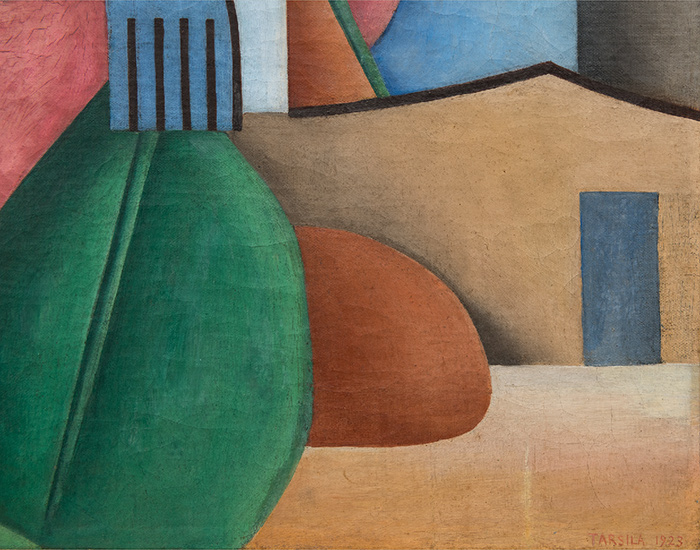
Most notable works
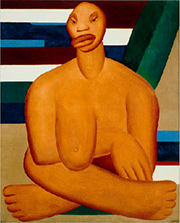
A Negra, 1923
Óleo sobre tela [Oil on canvas]
100 x 80 cm
Localização [Location]: Museu de Arte Contemporânea da Universidade de São Paulo, São Paulo, Brasil
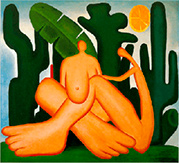
Antropofagia, 1929
Óleo sobre tela [Oil on canvas]
126 x 142 cm
Localização [Location]: Fundação José e Paulina Nemirovsky, São Paulo, Brasil
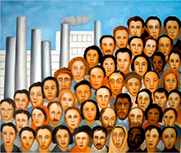
Operários, 1933
Óleo sobre tela [Oil on canvas]
150 x 205 cm
Localização [Location]: Acervo Artístico-cultural dos Palácios do Governo do Estado de São Paulo, Brasil
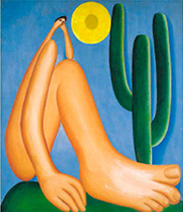
Abaporu, 1928
Óleo sobre tela [Oil on canvas]
85 x 73 cm
Localização [Location]: Museo de Arte Latinoamericano de Buenos Aires, Buenos Aires, Argentina
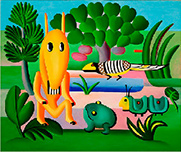
A Cuca, 1924
Óleo sobre tela [Oil on canvas]
73 x 100 cm
Localização [Location]: Musée de Grenoble, Grenoble, France
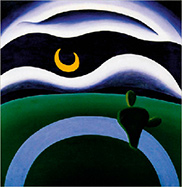
A Lua, 1928
Óleo sobre tela [Oil on canvas]
110 x 110 cm
Localização [Location]: Museum of Modern Art, New York, USA
Timeline
[1886] Tarsila is born in the small town of Capivari, São Paulo, Brazil, on September 1st. She is the second of seven children born to coffee growers José Estanislau do Amaral and Lydia Dias de Aguiar do Amaral.
She spends her childhood on the São Bernardo and Santa Teresa do Alto farms (the former in the municipality of Rafard, a district of Capivari at the time, and the latter in Monte Serrat, an equally small municipality now officially named Itupeva).
[1903-1905] Tarsila attends the Sacré-Coeur de Jésus boarding school in Barcelona, Spain, where her first artistic experience is a drawing of the Sagrado Coração de Jesus, which she copied from an European picture in the school’s collection.
[1906] On January 18th Tarsila gets married to a physician — Dr. André Teixeira Pinto —, a cousin of her mother’s. The couple spend their honeymoon in Argentina and Chile. That was Tarsila’s choice, and quite an adventurous trip at the time. Soon afterwards, they move to the São Bernardo farm, where Tarsila’s first and only daughter is born in the same year. Later on, they move on to the Sertão farm.
[1916-1919] These are Tarsila’s formative years as an artist. Still living in São Paulo, she studies modeling with Wilhelm Zadig and Oreste Mantovani — the former of Swedish extraction; the latter, Italian.
From 1917 to 1919, Tarsila studies drawing with Pedro Alexandrino, who guides her through the setting up of a private studio school — the first “artist’s atelier” in town (at Vitória Street) — where Alexandrino himself ends up teaching.
[1920-1921] In early 1920, Tarsila attends classes taught by Georg Elpons, who — according to her — “is the only impressionist teacher living in São Paulo.”
On June 3rd, Tarsila leaves for Europe once more, this time with her daughter, aboard the SS Deseado. Before she leaves, she leases her atelier to Elpons. Dulce attends a boarding school in London.
Tarsila settles down in Paris — first in a hotel, then at the Rue du Louvre.
Tarsila attends the Académie Julian: at first, her work is restricted to the study of nude drawings. The following year, she starts to work on paintings of live models. She then starts attending Emile Renard’s studio school.
Passa a frequentar o ateliê de Emile Renard.
[1922] In April, Tarsila’s Portrait de Femme is accepted at the Salon Officiel des Artistes Française. Tarsila shares an atelier at Neuilly-sur-Seine with Angelina Agostini, a Brazilian painter. By June she returns to Brazil.
Back in São Paulo, she is introduced to the Modernist Community by Anita Malfatti. She then becomes a member of the Grupo dos Cinco [Group of Five], which included Anita, Menotti Del Picchia, Mário de Andrade and Oswald de Andrade. Oswald and Tarsila start an affair.
In September, Tarsila presents her A Espanhola painting at the First General Exhibition of Fine Arts set up by the Sociedade Paulista de Belas Artes [São Paulo Society of Fine Arts] at the Palácio das Indústrias.
In early December, Tarsila returns to Europe and settles down in Paris once more. She now lives at Rue Hégésippe Moreau, not far from the Place de Clichy and the Villa des Artistes. Oswald, too, travels to Europe to meet Tarsila.
[1923] In January and February, Tarsila and Oswald travel around in Portugal and Spain.
In April, Tarsila starts attending André Lhote’s studio school.Tarsila and Oswald meet Blaise Cendrars. Tarsila studies with Albert Gleizes for a short time. Under his guidance, she does several structural exercises.
In October, Tarsila presents her painting, A Negra, to Fernand Léger. She often visits him at his atelier. At her own atelier, she is visited by critic Maurice Raynal and Léonce Rosenberg, an art dealer from the L’Effort Moderne gallery.
By December, Tarsila comes back to Brasil aboard Orania.
[1924] Blaise Cendrars comes to Brasil at Paulo Prado’s invitation. Tarsila, Oswald, Mrs. Olívia Guedes Penteado and Cendrars spent their Carnival holidays in Rio de Janeiro.
On March 18th, Correio da Manhã [The Morning Post] publishes Oswald de Andrade’s Manifesto da Poesia Pau-Brasil, from which he derives the term that is applied to Tarsila’s paintings of this period.
Tarsila joins the so-called “modernist caravan”. They travel throughout the historical cities of Minas Gerais State during Holy Week.
In September, Tarsila returns to Paris aboard the SS Almanzora.
In December, Blaise Cendrars’ book — Feuilles de route–I. de Formose (Roadmaps–I. de Formose), with illustrations by Tarsila — is released. The cover of the book features a reproduction of A Negra.
[1925] In January, Tarsila gets settled on Boulevard Berthier in Paris: “a period of silent work”. In March, she returns to Brazil aboard the SS Lutetia. Once in São Paulo, she settles down on Alameda Barão de Piracicaba (Barão de Piracicaba Boulevard).
In December, Tarsila and Oswald leave for Paris on a “prenuptial” trip aboard the SS Cap Polonio. In their homage, Mário de Andrade writes the poem “Tarsiwaldo”.
[1926] In January, Tarsila and Oswald leave Marseilles on a cruise throughout the Middle East, accompanied by their children and the couples Cláudio de Souza and Altino Arantes.
In March, back again in France, they start making preparations for Tarsila’s first solo exhibition to be held in Paris.
Tarsila’s exhibition is held on June 7-23 at André Level’s Galerie Percier (rue La Boétie). Seventeen of her paintings are displayed, in addition to drawings and watercolors. At the suggestion of the exhibition’s marchand, Tarsila’s paintings are framed by Pierre Legrain. The corresponding catalogue includes some of Cendrars’ poems and, on its cover, a reproduction of Tarsila’s self-portrait.
The exhibition is highly praised by the local newspapers. Acting on a suggestion by Maximilian Gauthier, Tarsila donates one of her paintings — A Cuca — to the Fonds National d’Art Contemporain (the National Fund for Contemporary Art). In 1928, A Cuca is taken to the Musée de Grenoble for safekeeping.
[1927] Tarsila and Oswald remain in Brasil. These are times of calm: their work pace is attenuated.
[1928] On January 11th, Tarsila gives Oswald a birthday present: a painting which would later be titled Abaporu (“man who eats human flesh” in the Tupi-Guarani language) and which would soon trigger the so-called anthropophagic movement.
In the same month, Tarsila and Oswald go back to Paris in order to make preparations for a new exhibition of Tarsila’s work. They take with them twelve of her canvases, all of them painted in Brazil. Tarsila’s second exhibition was also held at Galerie Percier between June 18th to July 2nd. Her paintings are once more framed by Legrain. When the exhibition ends, Tarsila and Oswald return to Brazil.
[1929] Tarsila’s first solo exhibition in Brasil takes place at the Palace Hotel in Rio de Janeiro between July 20th and July 30th. Thirty-five of her works are on display there — all of them painted between 1923 and 1929. The exhibition’s catalogue, which includes texts by Parisian art critics for the 1926 and 1928 exhibitions, as well as by Brazilian art critics, is designed and organized by Geraldo Ferraz. The same exhibition is also held at the edifício Glória (Glória building) in downtown São Paulo from September 17th to September 26th.
Through the mediation of Governor Júlio Prestes, São Paulo State purchases Tarsila’s São Paulo, a painting which was made part of the Pinacoteca do Estado (State Art Gallery) collection in 1931.
[1930] Tarsila participates in two collective exhibitions in Brasil: Exposição de uma Casa Modernista (Exhibition of a Modernistic House) at the house devised by Gregori Warchavchik (on Itápolis Street, in São Paulo) and Arte Moderna da Escola de Paris (Modern Art from the Paris School), organized by Géo-Charles and Vicente do Rego Monteiro (in both Rio de Janeiro and São Paulo).
Three of Tarsila’s paintings — Morro de Favela, Religião Brasileira e O Sapo — are displayed at The First Representative Collection of Paintings by Contemporary Brazilian Artists at New York’s Nicholas Roerich Museum.
Tarsila begins to work as director and artistic preserver of the Pinacoteca do Estado de São Paulo. She only works for a short time, however — for she loses her job as governor Júlio Prestes falls from power and Brazil’s “Second Republic” begins.
Tarsila leaves Oswald for good and gradually falls for Dr. Osório César, a Communist psychiatrist.
[1931] In March, Tarsila travels to Europe with Osório César. Their destination is the former U.S.S.R. On June 10th, the vernissage of her solo exhibition is held at the Museum of Western Art in Moscow. Russian critic Serge Romoff, cultural attaché of the Soviet Embassy in Paris and a friend of Tarsila’s, presents the exhibition’s opening speech. Among Tarsila’s works displayed at the exhibition is O Pescador, which was later purchased by the Museum (and is now kept at the Hermitage, in Saint Petersburg). At the same Museum Tarsila presents a lecture under the title of “A Arte no Brasil” [Art in Brazil.
By December, they return to Brazil.
[1933] Tarsila settles down on Alameda Barão de Limeira (Barão de Limeira Boulevard). She paints both Operários and Segunda Classe, which are displayed the following year at the 1o Salão Paulista de Belas Artes [First São Paulo Hall of Fine Arts.
In October, she sets up a retrospective exhibition at the Palace Hotel in Rio de Janeiro and displays 67 paintings and 106 drawings that she had made in the years 1920 – 1933.
[1936] Tarsila has a solo exhibition at Palácio das Arcadas in São Paulo. This year she starts writing chronicles for the Diário de São Paulo [The São Paulo Daily News], a collaborative effort which lasts until 1956.
[1937-1939] [In 1937 Tarsila regains her family’s Santa Tereza do Alto farm, where she starts living for long periods of time. She returns to pastoral themes in her paintings.
During these years, Tarsila participates in three Salões de Maio (May Salons), all of them sponsored by CAM (Clube dos Artistas Modernos). Some time during the last of these salons, she gives the lecture titled “Crítica e arte moderna” [Criticism and modern art]. The Revista Anual do Salão de Maio (Rasm) [Annual Journal of the May Salon — AJMS] includes the exhibition’s catalogue in its pages and publishes Tarsila’s article “Pintura Pau-Brasil e Antropofagia”.
[1945] Tarsila participates in the exhibition 20 Artistas Brasileños (20 Brazilian Artists), organized by Romero Brest and presented in Buenos Aires, La Plata, Montevideo and Santiago.
[1950-1951] In December 1950, seventy-two of Tarsila’s paintings are displayed at Tarsila, 1918–1950, an exhibition held at São Paulo’s Museu de Arte Moderna. The corresponding catalogue includes a presentation by Sérgio Milliet, director of the museum, and the article “Confissão Geral”, penned by Tarsila.
In the following year, she was awarded at the 1st Bienal de São Paulo with the Estrada de Ferro Central do Brasil (1924), a work incorporated in the Museum of Modern Art of São Paulo (today in the Museum of Contemporary Art of the University of São Paulo)
[1954] By the invitation of the Comissão do IV Centenário de São Paulo [São Paulo’s IV Centennial Committee] Tarsila paints a panel titled Procissão do Santíssimo [Procession of the Sacred Heart of Jesus] for the History Pavilion.
[1956] By the invitation of José de Barros Martins, Tarsila paints O Batizado de Macunaíma for Livraria Martins bookshop.
[1961] In February, Tarsila has a solo exhibition at Casa do Artista Plástico in São Paulo.
[1966] Tarsila participates in an exhibition titled Art of Latin America since Independence and held at different cities at the United States. The painting displayed is A Negra. The following year, her Antropofagia is included in a New York exhibition titled Precursors of Modernism in Latin America.
[1973] Tarsila passes away in São Paulo on January 17th. There have been several exhibitions and publications regarding Tarsila’s lifework since she died. Among them, two are worthy of mention: the seminal study made by Aracy Amaral on Tarsila’s 50 years of artistic production and the publication of the Catálogo Raisonné Tarsila do Amaral, bringing to light works which were literally unknown but which have been kept, in their majority, in private collections in Brazil and abroad.
Solo exhibitions
Galerie Percier: Paris, 7 de junho a 23 de junho de 1926 [June 7th to June 23th, 1926];
Galerie Percier: Paris, 18 de junho a 7 de julho de 1928 [June 18th to July 7th, 1928];
Palace Hotel: Rio de Janeiro, 20 de julho a 5 de agosto de 1929 [July 20th to August 5th, 1929];
Prédio Glória: São Paulo, 17 de agosto a 24 de agosto de 1929 [August 17th to August 24th, 1929];
Museu de Arte Moderna Ocidental: Moscou, 10 de junho a 30 de junho de 1931 [June 10th to June
30th, 1931];
Palace Hotel: Rio de Janeiro, outubro de 1933 [October, 1933];
Tarsila, 1918 – 1950. Museu de Arte Moderna: São Paulo, dezembro de 1950 a janeiro de 1951
[December, 1950 to January, 1951];
Casa do Artista Plástico: São Paulo, março de 1961 [March, 1961];
Sala Especial. VII Bienal de São Paulo: São Paulo, 28 de setembro a 22 de dezembro de 1963
[September 28th to December 22th, 1963];
Galeria Tema: São Paulo, dezembro de 1967 [December, 1967];
Tarsila: 50 anos de Pintura. Museu de Arte Moderna: Rio de Janeiro, abril a maio de 1969 [April to
May, 1969];
Tarsila: 50 anos de Pintura. Museu de Arte Contemporânea da Universidade de São Paulo: São Paulo,
maio a junho de 1969 [May to June, 1969];
Museu de Arte da Prefeitura de Belo Horizonte: Belo Horizonte, maio a junho de 1970 [May to June,
1970];
Tarsila do Amaral: Inventing Modern Art in Brazil. Chicago: The Art Institute of Chicago, 8 de outubro
de 2017 a 7 de janeiro de 2018 [October 8th, 2017 to January 7th, 2018]; New York: The Museum of
Modern Art (MoMA), 11 de fevereiro a 3 de junho de 2018 [Febuary 11th to June 3th, 2018].
Main group exhibitions
Salon de La Société des Artistes Français. Grand Palais des Champs Elysées: Paris, 1922
I Exposição Geral de Belas-Artes. Palácio das Indústrias: São Paulo, 1922
Maison de L’Amérique Latine: Paris, 1923
Salon des Indépendants: Paris, 1926
Salon des Vrais Indépendants: Paris, 1928
Salon des Surindépendants: Paris, 1929
Exposição de uma Casa Modernista: São Paulo, 1930
Exposition de L’École de Paris: Recife / Rio de Janeiro / São Paulo, 1930
First Representative Collection of Paintings by Brazilians Artists. The Roerich Museum:
New York, 1930
Salon des Surindépendants: Paris, 1931
I Exposição de Arte Moderna da SPAM. Sociedade Pró-Arte Moderna: São Paulo, 1933
I Salão Paulista de Belas-Artes: São Paulo, 1934
I Salão de Maio: São Paulo, 1937
II Salão de Maio: São Paulo, 1938
III Salão de Maio: São Paulo, 1939
Exposição Latino-Americana de Artes Plásticas. Riverside Museum: New York, 1939
I Salão de Arte da Feira Nacional de Indústrias: São Paulo, 1941
Exposição de Pintura Moderna Brasileira e Norte-Americana: São Paulo, 1944
Exhibition of Modern Brazilian Paintings. Royal Academy of Arts: Londres, 1944
Exposição de Pintores Norte-Americanos e Brasileiros. Museu Nacional de Belas-Artes:
Rio de Janeiro, 1944
20 Artistas Brasileños. Museo Provincial de Bellas Artes: La Plata / Museo Nacional de Bellas Artes:
Buenos Aires, 1945
Exposición de Pintura Contemporánea Brasileña. Instituto de Extensión de Artes Plásticas: Santiago,
novembro de 1946 [November, 1946]
Galeria Domus: São Paulo, 1946
I Bienal do Museu de Arte Moderna de São Paulo. Museu de Arte Moderna: São Paulo, 20 de
outubro a 23 de dezembro de 1951 [October 20th to December 23rd, 1951]
Exposición Pintura, Dibujos y Grabados Contemporáneos del Brasil. Museo de
Arte Contemporáneo
de la Universidad de Chile: Santiago, 1952
II Bienal do Museu de Arte Moderna de São Paulo. Museu de Arte Moderna: São Paulo, 13 de
dezembro de 1953 a 26 de fevereiro de 1954 [December 13th, 1953 to February 26th, 1954]
The 1955 Pittsburgh International Exhibition of Contemporary Painting.
Department of Fine Arts of
Carnegie Institute: Pittsburgh, 1955
Arte Moderno en Brasil. Museo Nacional de Bellas Artes: Buenos Aires, 1957
XXXII Esposizione Biennale Internazionale d’Arte: Veneza, 20 de junho a 18
de outubro de 1964 [June
20th to October 18th, 1964]
Art of Latin America Since Independence. The Yale University Art Gallery:
New Haven / The University
of Texas Art Museum: Texas, 1966
Art of the Fantastic: Latin America, 1920-1987. The Queens Museum: New
York, 10 de outubro a 6 de
dezembro de 1987 [October 10th to December 6th, 1987]
Modernidade: Art Brésilien du 20ème Siècle. Musée d’Art Moderne de la Ville de Paris: Paris, 10 de
dezembro de 1987 a 14 de fevereiro de 1988 [December 10th, 1987 to February 14th, 1988]
Art in Latin America: The Modern Era, 1829-1980. The Hayward Gallery: London, 1989
Brasilien Entdeckung und Selbstentdeckung. Junifestwochen Zürich: Zürich, 1992
Latin American Artists of the Twentieth Century. The Museum of Modern Art - MoMA: New York, 6 de
junho a 7 de setembro de 1993 [June 6th to September 7th, 1993]
Arte Brasileira na Coleção Fadel. Centro Cultural Banco do Brasil: Rio de Janeiro, 26 de fevereiro a
28 de abril de 2002 [February 26th to April 28th, 2002] / Centro Cultural Banco do Brasil: São Paulo,
23 de novembro de 2002 a 12 de janeiro de 2003 [November 23th, 2002 to January 12th, 2003]
Tarsila do Amaral e Di Cavalcanti: Mito e Realidade no Modernismo
Brasileiro. Museu de Arte
Moderna de São Paulo: São Paulo, 25 de outubro a 15 de dezembro de 2002 [October 25th to
December 15th, 2002]
Ao Mesmo Tempo o Nosso Tempo. Museu de Arte Moderna de São Paulo: São Paulo, 5 de abril a 30
de abril de 2006 [April 5th to April 30th, 2006]
Fernand Léger: relações e amizades brasileiras. Pinacoteca do Estado de São Paulo: São Paulo, 4 de
abril a 7 de junho de 2009 [April 4th to June 7th, 2009]
Tarsila da Amaral. Fundación Juan March: Madrid, 6 de fevereiro a 26 de maio de 2009 [February 6th
to May 26th, 2009]
Modernismo no Brasil. Museu de Arte Contemporânea da Universidade de São Paulo: São Paulo, 7
de outubro de 2011 a 29 de janeiro de 2012 [October 7th, 2011 to January 29th, 2012]
Tarsila e Mulheres Modernas no Rio. Museu de Arte do Rio (MAR): Rio de Janeiro, 12 de maio a 20 de
setembro de 2015 [May 12th to September 20th, 2015]
Arte no Brasil: Uma história na Pinacoteca de São Paulo. Pinacoteca do Estado de São Paulo: São
Paulo: 22 de outubro de 2016 a 26 de agosto de 2019 [October 22th, 2016 to August 26th, 2019]
Modos de Ver o Brasil: Itaú Cultural 30 Anos. Oca: São Paulo, 25 de maio a 13 de agosto de 2017
[May 25th to August 13th, 2017]
